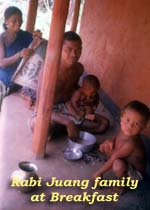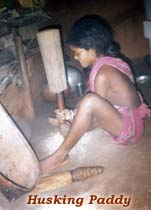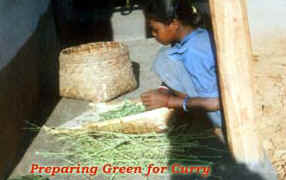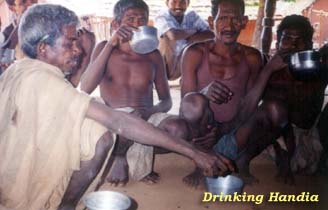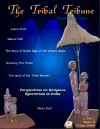Juanga Food
 |
Juang Food |
|||||||||||||||||||||||||||||||||||||||||||
|
INTRODUCTION The Juang – one of the primitive tribes, among, 62 tribes of Orissa, exclusively noticed in Orissa, are traditional shifting cultivators. In past, they were known as Pattoas for wearing leaves. In their language, the word 'Juang' means "sons of Man". Linguistically they belong to the Mundari speaking group. According to the 1991 census there are 35665 Juangs living in Orissa of which 13782 are in Keonjhar. The literacy rate is very less among the Juang. According to 1981 census it was only 8 %. The Juangs are presently noticed in Keonjhar, Mayurbhanj and undivided districts of Dhenkanal, Cuttack, Koraput, Sambalpur, Sundargarh, Phulbani, Bolangir, Puri and Balasore of Orissa. Although the Juang are found in number of districts in Orissa, they originally inhabited in the hilly region of Keonjhor district and the neighboring areas of present Angul district and in later stage they have migrated to the other areas in search of food. Integrated Tribal Development Agency (ITDA), Keonjhar, has made a survey in 1996 to know the details about the Juang. According to survey, there are 19362 Juang living in Keonjhar. They are distributed in 5 blocks mainly in Banspal, Telkoi, Harichandanpur, Ghatagaon and Keonjhar Sadar. Data have been collected by participatory and interview methods.The research village covered under the study include Panasanasa, Gungi and Duarsuni and others. The first two are ethnically homogeneous while Duarsuni is heterogeneous in nature. The first village Panasnasa, located at the top of the hill is more of traditional nature in comparison to other villages. The second village Gungi is at the slope of the hill where as the third village Duarsuni is situated at the base of the hill. FOOD
During the lean month (Tilai masa) that is Sraban & Bhadrava (July 15 to Sept 15 - October 15). The Juang take loan from the moneylender. According to S. Bose - "Juang pirh is a land of hungry nation. Though they require their square meals within a day yet they hardly get more than one proper full meal within a day and as such they fill their stomach with foodstuff other than rice and millets. In this land of hunger even the seeds of mango is also dried, then ground into powder and eaten by making pitha from that powder". (Bose 1967:108)
Arua: The rice is prepared only be husking the paddy. Finally winnowing separates rice. 1 boil Usuna: This rice is prepared by boiling the paddy in a pot for sometimes with small quantity of water. After water evaporates completely paddy are taken out and sun dried for 2/3 hours. Then the paddy are husked and winnowing separates rice. 2nd boil Usuna: This rice is prepared by boiling the paddy in a pot for sometimes with full quantity of water. After water evaporates completely paddy are taken out and sun dried for 2/3 hours. Then the paddy are husked and winnowing separates rice.
"The juang are ominivorus. In regards to food they are not in the least particular,eating all kind of flesh, including mice, rat, monkey, tiger, bear, snake, frogs, and even offal and for them the jungle abound in spotaneously produceed vegetable. In quest of food they posses all the instinct of the animals discerning at a glance what is nutritive and never mistaking a noxious for an edible fungus or root". ( Dalton 1872:152) There is no taboo in Juang culture against the consumption of beef. Some Juang profess not to eat beef, at least to outsider. (Mc.Douglas1963:14). In recent years there are meetings of the Juanga Sradars of various pirhs to review their customary rules and practices. On 25 April 1998, in one of such meetings held at the village Upper Bali, they decided that the Juangs should not take beef. If any body violates this rule, it was decided in this meeing to impose on him a fine of Rs. 1000/-.Such decision, according to some villagers, was taken earlier in 1985 in a meeting at Gonasika but some of the villager did not obey this rules.
This is an example of their effort to raise their acceptability by the neighbouring Hindus. Jungle Produce:
Basang : The Basang is collected from the jungle.House wives cut them into small round pieces and keep them in the boiled water for long time to wash away the bitter element. Then it is consumed after roasting. Mango carnel is also processed similarly and mixed with rice flour to prepare Cake (pitha). Ajang : In order to acquire the Ajang tuber,the Juang use the bulug stick to dig a deep pit after locating these roots from the surface vegetation.
Karep (Mushroom) : During rainy season this is available in the forest. These are collected to be consumed in rainy season (Lean period). The Juang consume careals such as Ragi, Jower, Maize, Kadu, Mandia, Guldi, Kangu in addition to the rice. The pulses like, Harada, Black gram, Gram, beans and sutri are consumed by them. The rich Juang spent 60 to 70 percent of his income for food. The poor Juang spent 80 to 90 percent of his income for food.
Rice beer or handia is the most common alcoholic drink among the Juang. But they prepare handia only in special occasion. The Munda tribe of the nearby villagers prepare handia and sell in the village market. When the Juang goto weekly market they drink handia or mahuli. To eat meat the Juang rear fowls, goats, sheep, pigs. Some time they hunt wild pig, deer, sambar, pecock during harvest season & summer season. In rainy season they collect masrooms and eat as a curry with rice. In rainy season the Juang catch fish, crab from the near by stream or from the agricultural field. In summer season they catch fish from the nearly pond with net. Red ant is collected from the forest and is eaten with rice. It is also taken with either Handia or mahuli as Chakhana. |
Photographs : Author
Illustrations :
References :
-
Bose,S 1967 Carrying capacity of land under shifting cultivation. Culcatta: The Asiatic Society .
-
Elwin,V 1948 Notes on the Juang. Man in India
-
E.T.Dalton 1872 Descriptive Ethnology of Bengal .
-
Mc.Daugal 1963 The social structure of hill Juang. Unpublished Ph. D thesis. University of New Mexico
-
Pattnaik,N. 1988 Shifting Cultivation in Orissa. , Adivasi, vol-xxviii, No –1, Bhubaneswar:S.T.S.C.R.T.I.
-
R.K. Nayak, B.M. Boal & N. Soreng(1993) The Juangs: A Handbook for Development, NISWAS, Bhubaneswar
![]()
| Our Contributors
Please send in your comments, ideas & suggestions to
|
| Note to Contributors: |
| The Tribal Tribune accepts in print or in electronic format the articles on any aspect of the tribal life and its changes. The articles must be in English in simple sentences. The graphs and pictures must be properly labeled or captioned with specific mention about its location in the article. The contributor must submit his/her short biodata along with a photograph. The editorial board reserves the right to modify or alter the original article consistent with the objective of this e-zine. |

